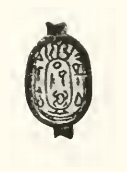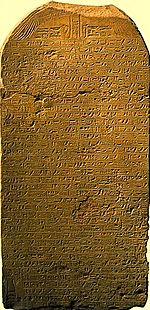Kamose facts for kids
Quick facts for kids Kamose |
|
|---|---|

Sarcophagus of Kamose, Cairo Egyptian Museum
|
|
| Pharaoh | |
| Reign | c. 1555–1550 BC (17th Dynasty) |
| Predecessor | Seqenenre Tao |
| Successor | Ahmose I |
| Consort | Ahhotep II (?) |
| Children | Ahmose-Sitkamose (?) |
| Father | Seqenenre Tao? |
| Mother | Ahhotep I? |
| Died | 1550 BC |
Kamose was an ancient Egyptian pharaoh. He was the last king of the Theban Seventeenth Dynasty. He was likely the son of Seqenenre Tao and Ahhotep I. He was also the full brother of Ahmose I, who later founded the Eighteenth Dynasty. Kamose ruled at the very end of a period called the Second Intermediate Period. He is usually thought to have reigned for about three years, but some experts believe he might have ruled for up to five years.
Kamose's reign was very important because he started strong military actions against the Hyksos. The Hyksos were foreign rulers who controlled a large part of Ancient Egypt. Kamose's father had begun fighting the Hyksos and died in battle. It is believed that Kamose's mother, as a regent (someone who rules for a young king), continued the fight after Kamose's death. His brother, Ahmose, eventually defeated the Hyksos and united all of Egypt.
Contents
Kamose's Military Campaigns
Why Did Kamose Fight?

Kamose was the last in a line of Egyptian kings ruling from Thebes. Before his father, the Theban rulers had been peaceful with the Hyksos kingdom to their north. The Thebans controlled Upper Egypt up to Elephantine and parts of Middle Egypt. Kamose wanted to expand his rule over all of Lower Egypt.
His advisors were not happy about this plan. They had a peaceful agreement with the Hyksos. This agreement allowed them to travel through Hyksos lands and graze their cattle in the fertile Nile Delta. Kamose's own records, found on the Carnarvon Tablet, show his council's worries about going to war:
See, all are loyal as far as Cusae. We are tranquil in our part of Egypt. Elephantine is strong, and the middle part (of the land) is with us as far as Cusae. Men till for us the finest of their lands. Our cattle pasture in the Papyrus marshes. Corn is sent for our swine. Our cattle are not taken away... He holds the land of the Asiatics; we hold Egypt..."
However, Kamose's father had already started fighting the Hyksos. Kamose wanted to take back what he believed was rightfully his: the kingship of all Egypt. He replied to his council:
I should like to know what serves this strength of mine, when a chieftain in Avaris, and another in Kush, and I sit united with an Asiatic and a Nubian, each in possession of his slice of Egypt, and I cannot pass by him as far as Memphis... No man can settle down, when despoiled by the taxes of the Asiatics. I will grapple with him, that I may rip open his belly! My wish is to save Egypt and to smite the Asiatic!"
Kamose felt a strong sense of national pride. He was also continuing the aggressive military plans of his father, Seqenenre Tao.
Fighting in the North
In his third year as king, Kamose started his military campaign against the Hyksos. He sailed north from Thebes on the Nile River. His first stop was Nefrusy, a city north of Cusae. This city had an Egyptian army loyal to the Hyksos. Kamose's special Medjay troops attacked and took over the garrison there.
Kamose's strategy was to quickly move up the Nile. He would capture small villages and Hyksos outposts. If a city resisted, he could cut it off by taking the next city to the north. This allowed him to advance quickly.
A second stone tablet (stela) found in Thebes continues Kamose's story. It tells how his soldiers captured a messenger. This messenger was carrying a letter from the Hyksos king, Apopi, to the ruler of Kush. The letter asked for urgent help against Kamose. Kamose quickly sent troops to destroy the Bahariya Oasis in the western desert. This oasis controlled an important desert trade route. Kamose did this to protect his army from attacks from behind.
Kamose then sailed back south to Thebes. He celebrated a big victory. He had pushed the border of his kingdom northward. The new border was now past Hermopolis to a place called Sako. This area became the new frontier between the Theban kingdom and the Hyksos state.
First Campaign in Nubia
Kamose had also fought against the Kushites (people from Nubia) before his third year as king. We know this because the captured letter from the Hyksos king Apophis asked the Kushite king to attack Kamose. Apophis said Kamose had caused trouble for both their kingdoms. It would have been very difficult for Kamose to fight both the Kushites in the south and the Hyksos in the north at the same time.
How Long Did Kamose Rule?
Kamose's third year is the only date we have for his reign. For a long time, people thought this was when his rule ended. However, it now seems that Kamose ruled for one or two more years. This is because he started a second military campaign against the Nubians.
Evidence for Kamose's first campaign against the Kushites comes from Apophis's captured letter. In Kamose's Year 3 stela, Apophis's plea for help from the Kushite king is recorded:
Do you see what Egypt has done to me? The ruler who is in it, Kamose-the-Brave, given life, is attacking me on my soil although I have not attacked him in the manner of all he has done against you. He is choosing these two lands to bring affliction upon them, my land and yours, and he has ravaged them."
Two rock carvings found in Nubia show the names of Kamose and Ahmose side by side. They were carved at the same time. Both kings are called di-ˁnḫ, meaning Given Life, which was used for ruling kings. This suggests that both Kamose and Ahmose were ruling together (co-regents) when the carvings were made. Since Kamose's name is first, he was the main ruler.
Kamose's Year 3 stela does not mention Ahmose as king. This means Kamose likely made Ahmose his junior co-regent sometime after his third year. This happened before Kamose started his second military campaign against the Nubians. So, Kamose's second Nubian campaign must have happened in his fourth or fifth year. Kamose might have attacked the fortress at Buhen in Nubia. The Nubians had taken it back from Kamose's forces. A stela with Kamose's name there was erased, and the fort shows fire damage.
Experts now estimate Kamose reigned for about five years, from 1554 BC to 1549 BC. This includes a one-year period when Ahmose and Kamose ruled together. Kamose was buried simply, in a plain coffin. This might mean he died before he could finish his royal burial items, perhaps because he was busy fighting.
Kamose's Mummy
Kamose's mummy is mentioned in the Abbott Papyrus. This document describes an investigation into tomb robberies during the reign of Ramesses IX, about 400 years after Kamose died. His tomb was said to be "in a good state." However, his mummy was later found in 1857 at Dra' Abu el-Naga'. It seemed to have been hidden on purpose in a pile of debris.
Early Egyptologists, Auguste Mariette and Heinrich Brugsch, found the painted coffin. They noted that the mummy was in very poor condition. Buried with the mummy were a gold and silver dagger, amulets, a scarab beetle charm, a bronze mirror, and a pectoral (a chest ornament). This pectoral had the name of his successor and brother, Ahmose.
The coffin is still in Egypt. The dagger is in Brussels, and the pectoral and mirror are in the Louvre Museum in Paris. The pharaoh's name on the coffin was only recognized 50 years after it was found. By then, the mummy, which had been left with the debris, was almost certainly lost.
Kamose's Stelae
Kamose put up two large stone tablets, called stelae, in Thebes. They seem to tell a continuous story of his victories over the Hyksos. The first stela is missing its last part. The Carnarvon Tablet also has some of the text from these stelae.
Finding the Stelae
In 1916, Sir Alan Gardiner thought that the First Carnarvon Tablet must be a copy of a stela from Pharaoh Kamose. This was later proven true. French Egyptologists Lacau and Chévrier found two pieces of a stela in Karnak. The smaller piece was found in 1932, and the larger one in 1935. This showed that the Carnarvon Tablet text was indeed copied from Kamose's stelae. These new texts were published in 1939.
Other Discoveries
More recently, other inscriptions of Kamose have been found.
- In 2004, a broken inscription with Kamose's Two Ladies name was found in Karnak. It was called the third stela of Kamose.
- In 2008, another inscription of Kamose was found in Armant.
Images for kids
See also
 In Spanish: Kamose para niños
In Spanish: Kamose para niños







